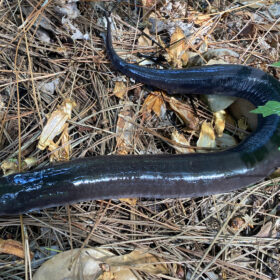I am by no means a fisherperson. Bucko has tried to get me interested, but the last time he tried, years ago, it was a total failure. We were at the Fort Clinch jetties and Bucko kindly lugged two chairs, buckets, fishing gear, ice chest, etc. to his favorite spot and set me up with a pole, bait and whatever. Within minutes I had gotten bored with holding a pole and left my chair to wander off to talk to other nearby people who were hunting shark teeth, all ideas of waiting for a fish abandoned. Bucko gave up on me, and rightly so.

So now it is amusing to him to watch my fishing attempts in our backyard retention pond. My motivation is a strong one: I am trying to provide live fish for practice for Vedra, a young rescued hand-raised orphaned otter that will be released to the wild soon. It is important that this captive otter learns about natural food sources and I have taken on the task to provide the Ark Wildlife Care and Sanctuary with live food for her. I’ve procured mud minnows from Amelia Island Bait and Tackle and Jonathan at the ARK has provided some crayfish but we wanted bigger fish for her to experience. Bucko suggested I try our own backyard retention pond. Good idea! Quick as can be, with Bucko’s help, I had mesh fish traps from Amazon baited with cat food and placed in our pond.
What a learning experience this was. When I excitedly yanked the trap from the water the first time there was something very strange inside the trap. Was this slinky, slimy long-bodied creature an eel? It looked like one but what were those projections behind its head? It turns out that this catch was a two-toed amphiuma–a giant salamander! I had never seen one before and neither had Bucko. Interesting. But it was dead. Of course. Salamanders are amphibians that breathe air at the surface when adults and this poor thing drowned. I’ve now learned that these giant salamanders are common in retention ponds in Florida but very few people ever see them. They hide in the mud and forage for insects and small fish, mostly at night. During their breeding season they lay up to 200 eggs in nests under leaf litter in muddy areas near water and are hatched with external gills that they lose as they mature. I had no idea these creatures live here! What a catch, but alas, a dead one.

The next time I pulled up a trap I found a drowned baby pond turtle, also an air-breather. Obviously, this fishing technique would not work for me, despite the bream fish that the net also caught. I looked up “turtle excluder devices” that are now mandatory for crab traps and a bigger version for shrimp trawls, but nothing would work with our cheap little mesh traps. Then we came up with the idea to use Styrofoam to make floats that kept the top of the trap above water where any captured air-breather could get to the surface and breathe. No more drowned amphibians and reptiles for us!

Soon after our traps were loaded with bream and the occasional baby turtle, alive, that I released again. Great! I successfully transported our first big batch of fish to the ARK in a bucket with an air bubbler, and Vedra had a ball catching and eating them. Johnathan set up some large water troughs with bubblers and fresh water awaiting my return with more fish. I was excited to catch more, and more and more. Or so I thought. But the next time I pulled up both baited traps I found no fish at all. It didn’t take long to figure out why. Some creature or another had ripped up the mesh netting of the trap, stealing the bait and letting all the fish escape. The traps were ruined.

Our guess is that the turtles in the pond had their revenge and tore up the traps to get at the bait. Obviously, nylon mesh traps are not the answer. Right now I am eagerly awaiting new metal traps to reach us from Amazon, which we will have to reengineer again. Meanwhile, I guess, it is back to mud minnows for Vedra.
And you know what? Fishing can be fun! It’s taken me decades to figure this out. As long as I don’t have to stand or sit still for hours with a fishing pole, I’m all in!
Pat Foster-Turley, Ph.D., is a zoologist on Amelia Island. She welcomes your nature questions and observations. [email protected]
